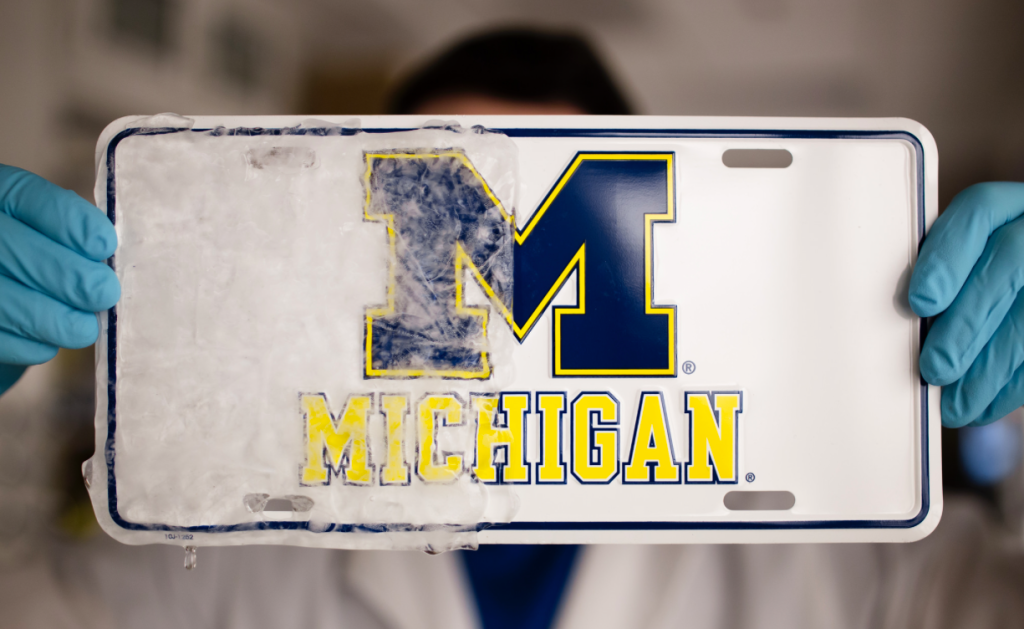
[Image above] A new rubbery, durable “icephobic” coating developed by researchers at the University of Michigan was applied to the right half of a license plate, preventing ice from sticking to that half after being placed in a freezer. Image credit: Evan Dougherty, Michigan Engineering
It may be officially spring in the Midwest, but anyone who lives in this region of the U.S. knows that April weather is particularly fickle.
In one day, Midwesterners might experience bright sunshine and comfortable temperatures, followed by a thunderstorm, random pebble-sized hail, and perhaps a blustery rain/snow mix by nightfall. Not to mention, of course, that hearty layer of ice to scrape off the car windshield the next morning.
That’s why any weather-savvy Midwesterner keeps that ice scraper handy until at least May.
And while scraping ice off your car windshield is sometimes painstaking, ice can make for downright hazardous conditions for vehicles. Extreme ice coating often keeps airplanes pinned to the tarmac, stranding weary, frustrated travelers.
Materials scientists know the struggle is real, and some are even dedicating their research to improving and simplifying ice removal for surfaces like aircraft wings, roads, and machines that need to be ice-free to work at full capacity.
Earlier this year, we covered research from the Key Laboratory of Bio-Inspired Smart Interfacial Science and Technology at Beihang University (Beijing, China) that’s looking to the feathers of Humboldt penguins to help inform next-level designs of icephobic membranes.
We also reported on research from Rice University (Houston, Texas), where chemists are developing a graphene composite material that is effective at melting ice on a helicopter blade—and that means it may be an effective real-time deicer for aircraft, wind turbines, transmission lines, and other surfaces exposed to winter weather.
Most recently, researchers at the University of Michigan (Ann Arbor, Mich.) are working on a new durable and inexpensive spray-on ice-repellent coating that is “thin, clear, and slightly rubbery to the touch that could make ice slide off equipment, airplanes, and car windshields with only the force of gravity or a gentle breeze,” according to a university news release.
The material is made of a blend of common synthetic rubbers—a formula that deviates from earlier approaches that made surfaces either extremely water-repellent or slippery.
“Researchers had been trying for years to dial down ice adhesion strength with chemistry, making more and more water-repellent surfaces,” Kevin Golovin, a doctoral student in materials science and engineering at the University of Michigan, says in the release. “We’ve discovered a new knob to turn, using physics to change the mechanics of how ice breaks free from a surface.”
During experimentation, the researchers found that water-repelling surfaces weren’t very effective at shedding ice. Instead, they noticed that rubbery coatings—even if they aren’t water repellent—actually work best for repelling ice due to a phenomenon called “interfacial cavitation.”
Here’s how interfacial cavitation works: Two rigid surfaces like ice and a car windshield can have a strong adhesive bond that can’t be broken without significant force, the release explains. But when a solid material is stuck to a rubbery surface, even a small application of force can deform the rubbery surface and break the solid material free of the bond.
“Nobody had explored the idea that rubberiness can reduce ice adhesion,” Anish Tuteja, associate professor of materials science and engineering and lead researcher, says in the release. “Ice is frozen water, so people assumed that ice-repelling surfaces had to also repel water. That was very limiting.”
Check out this video of the researchers demonstrating the durable, ice-repllent coating’s many applications.
Credit: Michigan Engineering, YouTube
When put through various lab stress tests, the new rubbery coatings impressively stood up to peel tests, salt spray corrosion, high temperatures, mechanical abrasion, and hundreds of freeze-thaw cycles.
And the coating is easily tunable.
By slightly altering the smoothness and rubbery quality of the coating, the team found it’s possible to fine-tune its degree of ice repellency and durability, depending on the application needed.
“An airplane coating, for example, would need to be extremely durable, but it could be less ice-repellent because of high winds and vibration that would help push ice off,” Golovin says. “A freezer coating, on the other hand, could be less durable, but would need to shed ice with just the force of gravity and slight vibrations.”
The team says this technology could have major implications in various industries, including energy, shipping, and transportation, where ice accumulation is a constant challenge in colder climates.
And we may see the coating commercially available in as little as a year.
“I think the first commercial application will be in linings for commercial frozen food packaging, where sticking is often a problem. We’ll probably see that within the next year,” Tuteja says. “Using this technology in places like cars and airplanes will be very complex because of the stringent durability and safety requirements, but we’re working on it.”
The research, published in the journal Science Advances, is “Designing durable icephobic surfaces” (DOI: 10.1126/sciadv.1501496).
